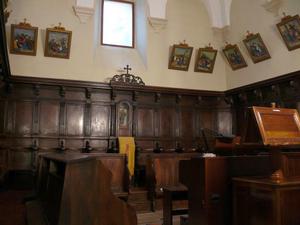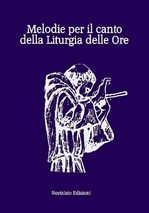Saint Francis and the Liturgy
Franciscans and the Liturgy: A Benedictine Point of View
Here and there in the family of the Seraphic Saint Francis of Assisi one finds communities that glow with a warm love for liturgical prayer. I’m thinking, in particular of the Poor Ladies of Bethlehem Monastery in Barhamsville, Virginia, where a warm and glowing love for the Sacred Liturgy has been fostered for many years. I’m thinking also of the Conventual Franciscan Friar at the Basilica of Saint Anthony in Padova who authors a splendid Italian blog: Cantuale Antonianum. The Franciscans of the Immaculate are known for their commitment to the liturgical cause as much as for their fervent and enlightened Marian piety. The Capuchins, for their part, have the following splendid passage in their Constitutions:
We direct the clerics and priests who are not legitimately impeded
to assemble as quickly as they can in the choir at the first sound of the bell in order
to prepare their hearts for the Lord. There, with devotion, recollection,
mortification, quiet and silence, let them bear in mind that they are before God
where they should take up the angelic office of rendering the divine praises.
We also instruct that the office be said with due devotion, attention, maturity,
uniformity of voice and in harmony with the spirit, without frills or distractedly,
and with the voice neither too high nor too low, but in between. The friars should
strive to sing psalms to God more with the heart than with the mouth so that what
our fair Saviour said of the Hebrews may not be said of us: “These people honour
me with their lips, but their heart is far from me.” We direct that the lay friars
assemble at the beginning of matins, vespers and compline, and at the Te Deum
laudamus. After making their preparation in common, they may withdraw
somewhere according to their devotion as the office is beginning and say the Our
Fathers as the Rule imposes on them. We also direct those the lay friars and clerics not impeded for a just reason to come together for vespers and for all the Masses they can on all the feastdays. (1536 Constitutions of the Friars Minor Capuchin)
Choirs Minor
I am old enough to remember having heard Franciscans of various allegiances chant the Divine Office in choir in Latin. It was impressive and profoundly edifying. The Franciscans of the Atonement at Graymoor were particularly marked by a love for the Divine Office inherited from their founders — both converts from Anglicanism — Father Paul James Francis Watson and Mother Lurana Mary Francis White.
 The Conventual Franciscans (O.F..M., Conv.) had, in many places, a strong commitment to choral prayer and a somewhat higher standard of liturgical performance than that cultivated by the (O.F.M.) Friars Minor, although the latter are not entirely without a few strongholds of choral liturgical prayer in Italy and, of course, in the Holy Land. The Capuchins, for their part, while reciting the Hours dutifully in choir, eschewed chant as a distraction and an impediment to recollection, and like so many movements of reform, invested more in the ways of mental prayer and a bracing asceticism than in choral liturgical prayer.
The Conventual Franciscans (O.F..M., Conv.) had, in many places, a strong commitment to choral prayer and a somewhat higher standard of liturgical performance than that cultivated by the (O.F.M.) Friars Minor, although the latter are not entirely without a few strongholds of choral liturgical prayer in Italy and, of course, in the Holy Land. The Capuchins, for their part, while reciting the Hours dutifully in choir, eschewed chant as a distraction and an impediment to recollection, and like so many movements of reform, invested more in the ways of mental prayer and a bracing asceticism than in choral liturgical prayer.
With the advent of the “peace and justice” enthusiasms of the 1970s, a serious commitment to choral liturgical prayer was judged, by many, incompatible with the “fundamental option for the poor” incumbent upon Franciscans in the post-conciliar age. Franciscans, Friars, Sisters, and even some Poor Clares, explored other non-liturgical or para-liturgical forms of prayer. Friaries and convents in which the complete cycle of the Hours was chanted in choir became extremely rare.
One must also identify a certain “anti-monastic” prejudice that has always dogged the mendicant Orders, and the Franciscans, in particular. The tired old refrain, “We are not monks,” became a useful excuse from any form of consistent regular observance and choral liturgical prayer. Certain practices were rashly identified as “too monastic” and swept aside in favour of a flawed notion of “simplicity” and “active participation.” This, in spite of the fact, that the Romano-Seraphic liturgical books included the full array of resources necessary for an integral celebration of the Mass and Divine Office in Gregorian Chant.
Embracing the Holy Father’s Vision
Pope Benedict XVI’s choice, in 2010, of Saint Francis of Assisi as a model of liturgical piety was a clarion call, invited all followers of the Poverello to examine their commitment to a full, liturgical life, including the choral celebration of all the Hours. Magnificent early Franciscan liturgical manuscripts, described by the famous Franciscan liturgiologist, Father Stephan J. P. Van Dijk, O.F.M., attest to the importance attached to the Sacred Liturgy by the sons and daughters of the Seraphic Patriarch. Perhaps now, after more than forty years of alienation from the sources of an authentically Franciscan liturgical spirituality, the children of the Little Poor Man of Assisi may be ready to embrace the vision of Pope Benedict XVI as a passage “from the world to God.”
The Saints Never Fade Away
[…] 1. In these days you have gathered in Assisi, the city in which “a sun was born to the world” (Dante, Paradiso, Canto XI), proclaimed patron of Italy by venerable Pius XII: Saint Francis, who preserves intact his freshness and his relevance – the saints never fade away! – due to his being conformed totally to Christ, of whom he was a living icon.
Saint Francis and the Breviary
Like our own, the time in which Saint Francis lived was also marked by profound cultural transformations, fostered by the birth of the universities, by the rise of the townships and by the spread of new religious experiences.
Precisely in that season, thanks to the work of Pope Innocent III – the same from whom the Poverello of Assisi obtained his first canonical recognition – the Church undertook a profound liturgical reform.
Its highest expression is the Fourth Lateran Council (1215), which numbers among its fruits the “Breviary.” This book of prayer incorporated the richness of the theological reflection and prayer experience of the previous millennium. By adopting it, Saint Francis and his friars made their own the liturgical prayer of the Supreme Pontiff: in this way, the saint assiduously listened to and meditated on the Word of God, to the point of making it his own and then transposing it into the prayers he authored, and into all of his writings in general.
Transubstantiation
The Fourth Lateran Council itself, devoting particular attention to the sacrament of the altar, inserted into the profession of faith the term “transubstantiation,” to affirm the real presence of Christ in the Eucharistic sacrifice: “His body and his blood are truly contained in the sacrament of the altar, under the species of the bread and wine, because the bread is transubstantiated into the body and the wine into the blood by divine power” (DS, 802).
We adore you, Lord Jesus
From attending holy Mass and receiving Holy Communion with devotion arose the evangelical life of Saint Francis and his vocation to retrace the steps of Christ Crucified: “The Lord,” we read in the Testament of 1226, “gave me such faith in churches that I would simply pray and say: We adore you, Lord Jesus, in all of your churches in the whole world, and we bless you, because with your holy cross you have redeemed the world” (Fonti Francescane, no. 111).
Reverence for Priests
This experience also gave rise to the great deference that he showed for priests, and his orders to the friars to respect them always and no matter what, “because I see nothing bodily of the Most High Son of God in this world, if not his Most Holy Body and Blood that they alone consecrate, and they alone administer at the altars” (Fonti Francescane, no. 113).
The Mystery Celebrated and Adored
Before such a gift, dear brothers, what responsibility of life follows for each one of us! “Be mindful of your dignity, brother priests,” Francis moreover urged, “and be holy, because he is holy!” (Letter to the General Chapter and to all of the friars, in Fonti Francescane, no. 220). Yes, the holiness of the Eucharist demands that one celebrate and adore this mystery mindful of its greatness, importance, and efficacy for Christian life, but it also demands purity, consistency, and holiness of life from each one of us, in order to be living witnesses of Christ’s one sacrifice of love.
The saint of Assisi never stopped contemplating how “the Lord of the universe, God and Son of God, is so humble as to conceal himself, for our salvation, in the paltry appearance of bread” (ibid, no 221), and vehemently asked his friars: “I beg you, more than if I were doing it for myself, that you humbly beseech the priests that they venerate above all things the Most Holy Body and Blood of our Lord Jesus Christ, and the Holy Names and the words written of him that consecrate the body” (Letter to all the Custodians, in Fonti Francescane, no. 241).
The Liturgy: Veritatis Splendor
The authentic believer, in every time, experiences in the liturgy the presence, the primacy, and the work of God. It is “veritatis splendor” (Sacramentum Caritatis, 35), nuptial event, foretaste of the new and definitive city and participation in it; it is the bond between creation and redemption, heaven open to the earth of men, passage from the world to God; it is Pascha, in the cross and resurrection of Jesus Christ; it is the soul of the Christian life, call to follow, reconciliation that moves to fraternal charity.
A Window that Opens Onto What Is Beyond Time
Dear brothers in the episcopate, your coming together places at the center of the work of the assembly an examination of the Italian translation of the third standard edition of the Roman Missal. The correspondence of the prayer of the Church (lex orandi) and the rule of faith (lex credendi) shapes the thought and sentiment of the Christian community, giving form to the Church, the body of Christ and temple of the Spirit. Human expression can never stand completely outside of its time, even when, as in the case of the liturgy, it constitutes a window that opens to what is beyond time. Giving expression to a perennially valid reality therefore demands a wise balancing of continuity and newness, of tradition and revitalization.
Every Reformer: Obedient to the Faith
The Missal itself takes its place within this process. Every true reformer, in fact, is obedient to the faith: he does not act in an arbitrary manner, he does not appropriate any discretion over the rite; he is not the owner, but the custodian of the treasury instituted by the Lord and entrusted to us. The whole Church is present in every liturgy: adhering to its form is a condition of authenticity for what is celebrated. […]
From the Vatican, November 4, 2010
Benedict XVI




